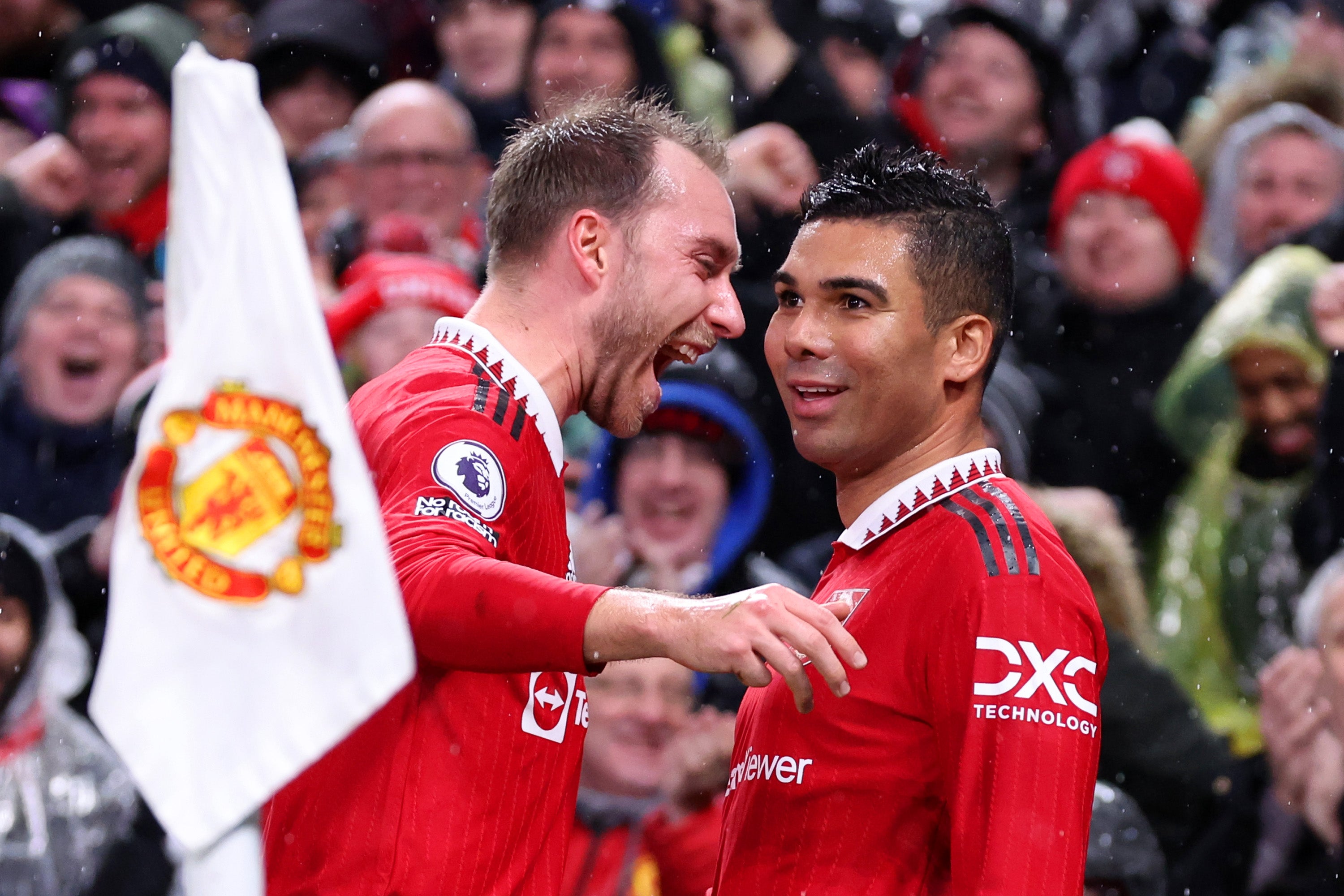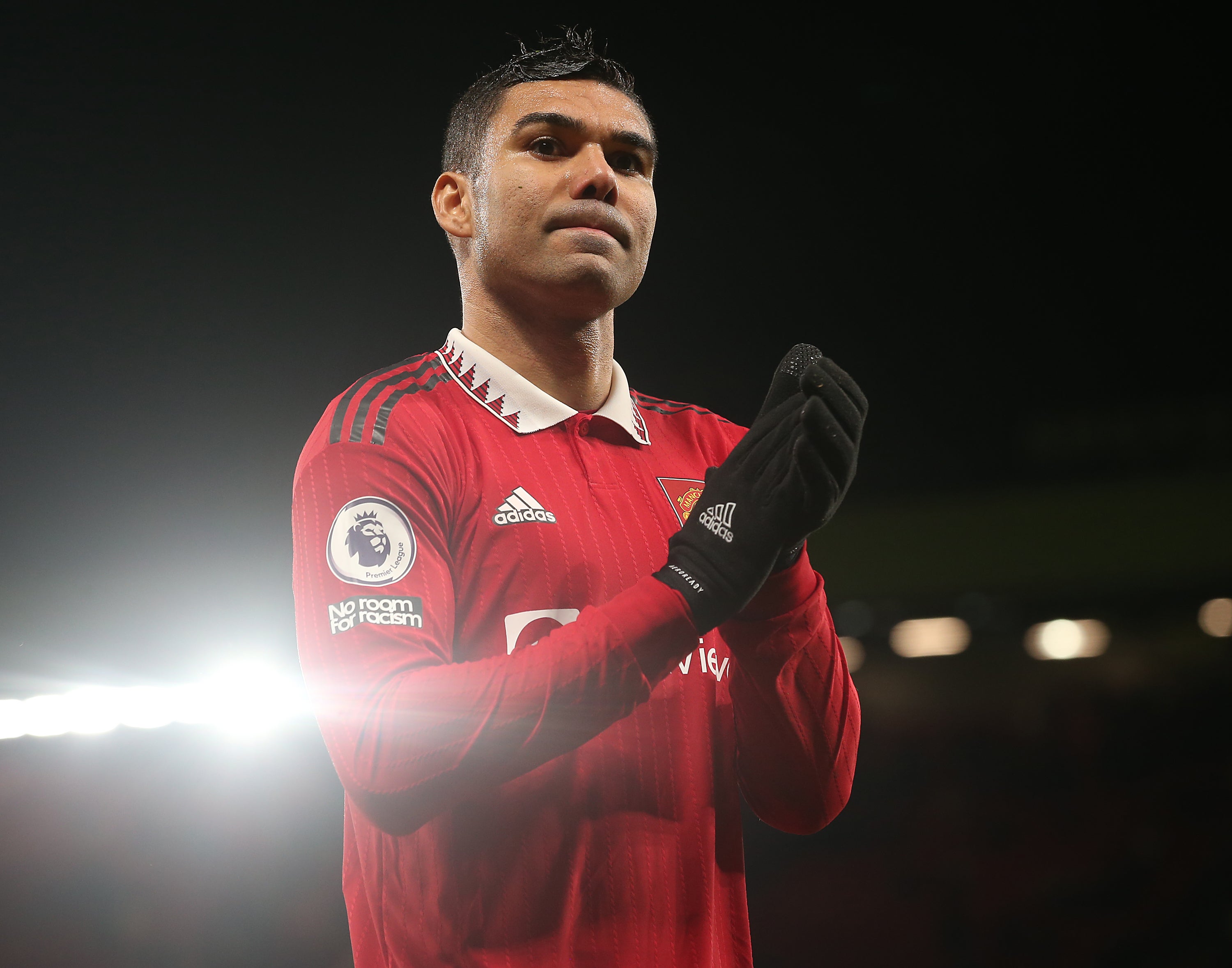Casemiro and Christian Eriksen alliance forms cornerstone of Manchester United revival
The Brazilian and Danish midfielders, who have added control to Erik ten Hag’s side, inspired victory over Bournemouth

Your support helps us to tell the story
From reproductive rights to climate change to Big Tech, The Independent is on the ground when the story is developing. Whether it's investigating the financials of Elon Musk's pro-Trump PAC or producing our latest documentary, 'The A Word', which shines a light on the American women fighting for reproductive rights, we know how important it is to parse out the facts from the messaging.
At such a critical moment in US history, we need reporters on the ground. Your donation allows us to keep sending journalists to speak to both sides of the story.
The Independent is trusted by Americans across the entire political spectrum. And unlike many other quality news outlets, we choose not to lock Americans out of our reporting and analysis with paywalls. We believe quality journalism should be available to everyone, paid for by those who can afford it.
Your support makes all the difference.Set-piece goals often feel as though they are made on the training pitch. When Casemiro volleyed in a Christian Eriksen free kick, it may have come from Carrington, but it was made in midfield, forged in a recruitment strategy that had failed Manchester United in too many previous transfer windows, created by Erik ten Hag.
There was a certain symbolism but they did not need to combine for a goal for their impact to be apparent. Ten Hag’s transformation of the club can be seen through the prism of Marcus Rashford’s form, or the way a disciplinarian has raised standards or simply the results as United, pointless after two games, now have a manager being asked if his team are title contenders. Or it could be seen in the sense that they have a midfield again.
Which, admittedly, should be taken for granted, especially at elite levels. Yet it is the area where United were found most wanting in recent years. They beat Bournemouth a year to the day since 2022 began at Old Trafford with a home defeat to Wolves. The classier midfield pair that day consisted of Ruben Neves and Joao Moutinho. Nor was it an unfamiliar tale. Nemanja Matic started then, disrupting an infamous double act. Scott McTominay and Fred are honest triers who, individually and as the much-mocked ‘McFred’ partnership, made some valuable contributions in the United cause. Yet even a £50 million price tag and a status as a Brazil international did not make the latter a midfield general. Put him alongside the Scot and many a mid-table team could argue their midfield was superior to United’s.
Not now. If Ten Hag showed a pragmatism in strengthening the weakest department of his side and an opportunism in taking Eriksen on a free transfer, if United’s vast resources enabled them to pay a £60 million fee for Casemiro and his considerable wages, he has nevertheless built from the middle. Eriksen and Casemiro have lent style and substance, though the division of responsibilities is not as simple as that. The Dane has a doggedness and a durability: he does not just garnish games.
The Brazilian is far more than just a defensive midfielder. Casemiro’s passing range means he also serves as a creator; his opener against Bournemouth was proof he can be a scorer. He lends an authority. He can seem a throwback to the days of midfield all-rounders who, it seemed, were capable of doing most things to a high standard.
Each has given a level of penetrative passing that McTominay rarely offered and Fred only intermittently. Eriksen’s assist was his sixth of the Premier League season: only Kevin de Bruyne has more and, since he returned to the division in February, just the Belgian, the Dane and Dejan Kulusevski are in double figures. Part of that stems from his set-piece specialism.
If there was a focus on free-kick takers last season, it was when Cristiano Ronaldo displaced Bruno Fernandes on those within shooting range. There has been rather less attention on some of the dead-ball situations from wider positions but Eriksen has felt an upgrade on Fernandes from the flanks. Rashford scored from Eriksen’s corner against Nottingham Forest, Casemiro from his free kick against Bournemouth. “The quality on the ball was obviously big,” the beaten manager, Gary O’Neil, said.

Which tends to be Eriksen’s forte. If United’s midfield now promises a blend of ability and nous that was lacking for swathes of recent seasons, Ten Hag detected a sloppiness in the closing stages against Bournemouth: certainly after Eriksen came off, though perhaps when Bournemouth had three chances in swift succession before his removal.
“We ended up with two departments, one attacking, one defending and a big space in between,” the manager lamented. “It cost a lot of energy. It was like a tennis match. You don’t want to play tennis, you want to play football.”
It felt out of character for this United; arguably in the closing stages, they missed Eriksen’s intelligence. If Fred was sent on to quieten the game down, he may have had the opposite effect. While Eriksen has low numbers for many a facet of a holding midfielder’s job, for tackles and interceptions, he can compensate with positional discipline and a capacity to read the game. Casemiro tends to be the nullifier and as a duo with differing attributes, they have made a difference. United have won 10 of the last 12 games they have started together.

Their alliance has formed the cornerstone of a revival. That loss of control, brief as it was, even as it was not reflected in the scoreline, highlighted what United have gained this season: a conviction, an air of assurance, some moments of mastery from a new-look combination of relative old-timers who know their game and the game. And that game is football, not tennis.



Join our commenting forum
Join thought-provoking conversations, follow other Independent readers and see their replies
Comments